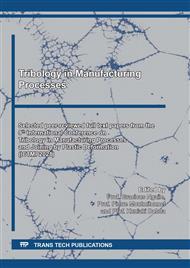[1]
P.J. Arrazola, T. Ozel, D. Umbrello, M. Davies, I.S. Jawahir, Recent advances in modelling of metal machining processes. CIRP Annals 62, 695–718. (2013).
DOI: 10.1016/j.cirp.2013.05.006
Google Scholar
[2]
J.F. Archard, Contact and Rubbing of Flat Surfaces. Journal of Applied Physics 24, 981 (1953).
DOI: 10.1063/1.1721448
Google Scholar
[3]
E. Usui, T. Shirakashi, T. Kitagawa, Analytical prediction of cutting tool wear. Wear 100, 129-151 (1984).
DOI: 10.1016/0043-1648(84)90010-3
Google Scholar
[4]
L.-J. Xie, J. Schmidt, C. Schmidt, F. Biesinger, 2D FEM estimate of tool wear in turning operation. Wear 258 1479–1490 (2005).
DOI: 10.1016/j.wear.2004.11.004
Google Scholar
[5]
T.H.C. Childs, Friction modelling in metal cutting. Wear 260, 310–318 (2006).
DOI: 10.1016/j.wear.2005.01.052
Google Scholar
[6]
T. Ozel, The influence of friction models on finite element simulations of machining. International Journal of Machine Tools and Manufacture 46, 518 – 530 (2006).
DOI: 10.1016/j.ijmachtools.2005.07.001
Google Scholar
[7]
L. Filice, F. Micari, S. Rizzuti, and D. Umbrello, A critical analysis on the friction modelling in orthogonal machining. International Journal of Machine Tools and Manufacture 47, 709 – 714 (2007).
DOI: 10.1016/j.ijmachtools.2006.05.007
Google Scholar
[8]
J. Rech, A. Giovenco, C. Courbon, F. Cabanettes, Toward a new tribological approach to predict cutting tool wear. CIRP Annals-Manufacturing Technology (2018).
DOI: 10.1016/j.cirp.2018.03.014
Google Scholar
[9]
A. Mondelin, F. Valiorgue, J. Rech, M. Coret, & E. Feulvarch, Hybrid model for the prediction of residual stresses induced by 15-5PH steel turning. International Journal of Mechanical Sciences, 58, 69–85 (2012).
DOI: 10.1016/j.ijmecsci.2012.03.003
Google Scholar
[10]
A. Giovenco, C. Courbon, F. Cabanettes, J.Rech, U.Masciantonio, H. Karaouni, E. D'Eramo, A. Van Robaeys, E. Jourden, Importance of the contact interface definition in the numerical simulation of tool wear in metal cutting. AIP Conference Proceedings. (2019).
DOI: 10.1063/1.5112615
Google Scholar
[11]
C. Courbon, T. Mabrouki, J. Rech, D. Mazuyer, E. D'Eramo, On the existence of a thermal contact resistance at the tool-chip interface in dry cutting of AISI 1045: Formation mechanisms and influence on the cutting process. CIRP Annals-Manufacturing Technology (2013).
DOI: 10.1016/j.applthermaleng.2012.06.047
Google Scholar
[12]
R.K. Rajan, H. Kumar, S.K. Albert, T.R. Vijayaram, Sliding friction and wear characteristics of grade 410 martensitic stainless steel. Applied Mechanics and Materials Vols. 592-594 pp.1346-1351 (2014).
DOI: 10.4028/www.scientific.net/amm.592-594.1346
Google Scholar
[13]
Mahesha N. S., Hanumantharaya R., Mahesh B. Davanageri, Ramakrishna Devananda P., Shivakumar K.M., Tribological Wear Behavior of AISI 630 (17-4 PH) Stainless Steel Hardened by Precipitation Hardening, American Journal of Materials Science, Vol. 6, pp.6-14 (2016).
Google Scholar
[14]
Attanasio, A., Ceretti, E., Fiorentino, A., Cappellini, C., Giardini, C. , Investigation and FEM-based simulation of tool wear in turning operations with uncoated carbide tools, Wear, 269/5–6: 344–350 (2010).
DOI: 10.1016/j.wear.2010.04.013
Google Scholar
[15]
Hosseinkhani, K., Ng, E., A combined empirical and numerical approach for tool wear prediction in machining, Procedia CIRP, 31:304–309, (2015).
DOI: 10.1016/j.procir.2015.03.087
Google Scholar


